Spring Break 2021
Monday, March 29, 2021 | News
The Studio will be closed for Spring Break from Monday March 29 through Sunday April 4. We re-open on our usual school-year schedule beginning Monday, April 5.
Basic Piano Buying Guide for Piano Students and Piano Parents
Wednesday, March 17, 2021 | Practicing and General Education
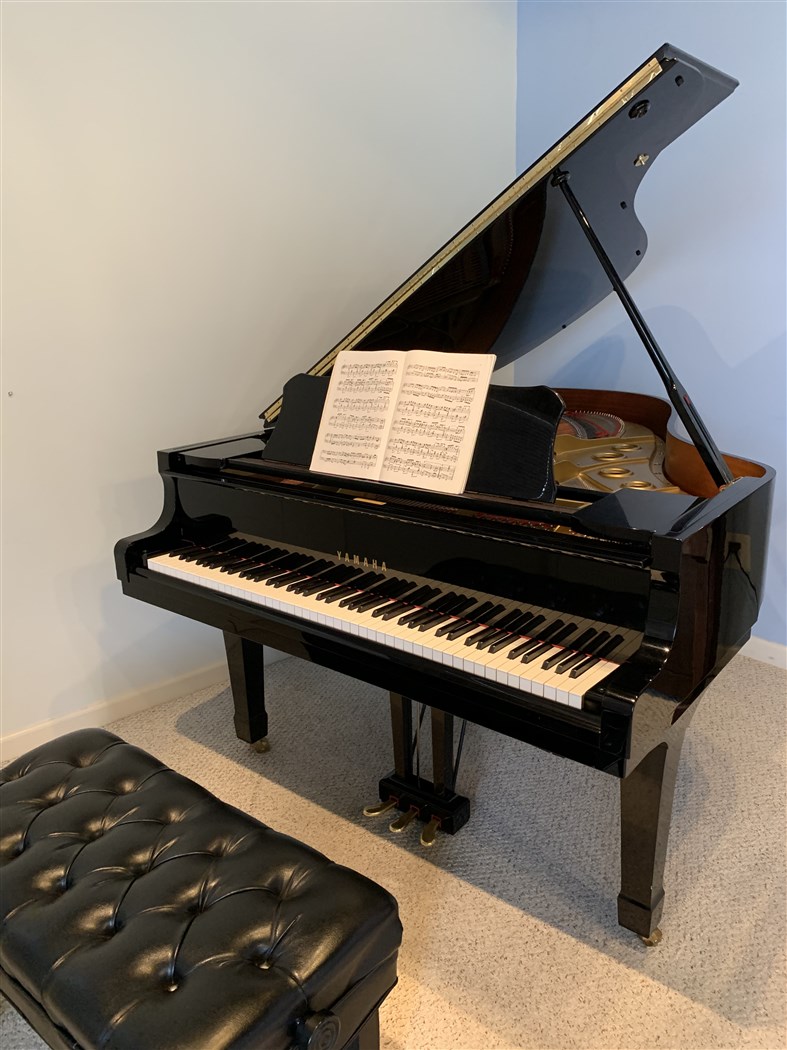 IN A NUTSHELL To maximize the chance of long-term success, invest in the best quality acoustic piano you can, as soon as you can. If you have the space and the means, buy a grand piano (over 5’9”). If a grand piano isn’t in the cards for you, buy a full-sized (46” to 52”) upright piano. A digital piano (or an acoustic piano in poor condition) will be a drag on student skill and motivation from day one. Even short practice sessions can add up to hundreds of hours over the course a couple years. When this time is spent on a quality acoustic piano, you have a higher chance of realizing your potential. In this guide, we quickly walk through all the ground-floor basics that new and returning piano students and piano parents need to know to begin making good purchase decisions.
IN A NUTSHELL To maximize the chance of long-term success, invest in the best quality acoustic piano you can, as soon as you can. If you have the space and the means, buy a grand piano (over 5’9”). If a grand piano isn’t in the cards for you, buy a full-sized (46” to 52”) upright piano. A digital piano (or an acoustic piano in poor condition) will be a drag on student skill and motivation from day one. Even short practice sessions can add up to hundreds of hours over the course a couple years. When this time is spent on a quality acoustic piano, you have a higher chance of realizing your potential. In this guide, we quickly walk through all the ground-floor basics that new and returning piano students and piano parents need to know to begin making good purchase decisions.
IF AN ACOUSTIC INSTRUMENT ISN’T POSSIBLE A digital keyboard with 88 weighted keys, stand, and pedal is acceptable for beginners and for students who are looking to learn basic keyboard skills but don’t imagine progressing to advanced levels. The most important feature to look for in a digital keyboard is “weighted keys,” which are essential to the development of finger-working muscles and a technique of controlled attack that will work on all instruments. Weighted keys are, in fact, not weighted, but spring-loaded so that they feel “heavy” as on a real piano. "Graded hammer action" is a marketing and technical term meaning that lower keys are slightly heavier than higher keys. This is a desirable feature and in the past a feature that separated higher quality instruments from budget models. "Semi weighted" means unweighted, at least for our purposes.
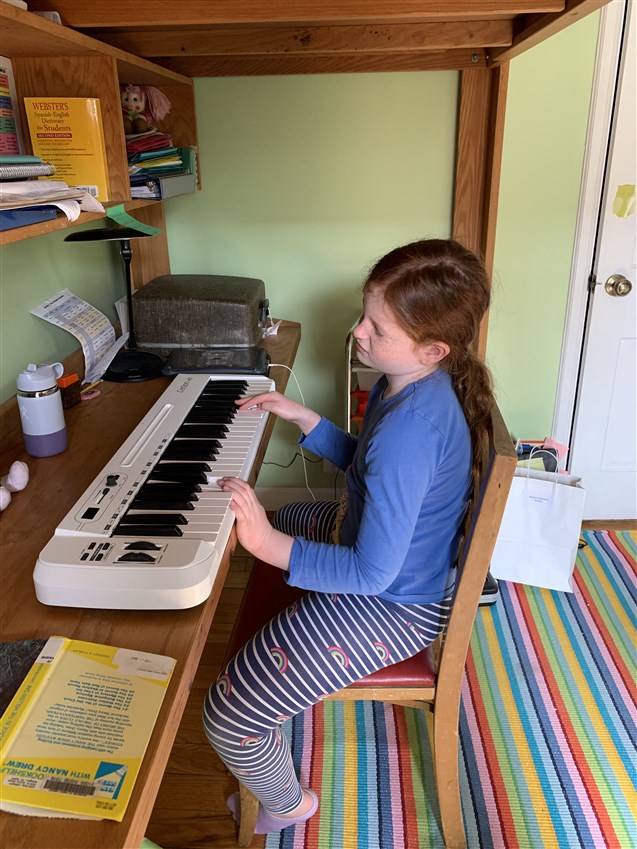 A FULL-SIZE KEYBOARD IS 88 KEYS You’ll rarely if ever find good-quality weighted keys on a less-than-full-sized keyboard. Do not be concerned about the space difference: an 88-key instrument will be no more than 14 inches wider than a 61-key instrument. All 88-key instruments (including all vertical acoustic pianos) are essentially the same width and take up the same amount of floor space.
A FULL-SIZE KEYBOARD IS 88 KEYS You’ll rarely if ever find good-quality weighted keys on a less-than-full-sized keyboard. Do not be concerned about the space difference: an 88-key instrument will be no more than 14 inches wider than a 61-key instrument. All 88-key instruments (including all vertical acoustic pianos) are essentially the same width and take up the same amount of floor space.
OTHER DIGITAL KEYBOARD FEATURES Many common electronic keyboard features can increase student engagement, especially in the short term. While these bells-and-whistles can be fun, they are unnecessary for basic musical and technical development. Recording capability, a built-in metronome with digital display, and a dual-headphone jack are useful—but not essential—features for student use.
DIGITAL VS ACOUSTIC An acoustic piano is an instrument which has strings and produces sound mechanically, without electricity. If you have to plug in your piano, it's digital (or electronic) instrument. An electronic keyboard is, at best, a poor substitute for a real piano. When a student learns to play on an acoustic instrument, they have the potential to learn how to manipulate a complex machine that can produce infinite gradations of tone and expression; when a student learns to play on a digital piano, they are pressing a button which prompts a computer chip to play a recording of a real piano. Let’s be honest: if you are trying to learn classical music or any sort of advancing piano technique on a digital keyboard, your instrument is limiting your progress…tremendously. Both practice time and your technical/physical skill accumulate from your first lessons. You can't wait until you are at an advanced level...because without adequate practice time on an acoustic piano, you are so much less likely to reach an advanced level! With the wide range of pianos and price ranges, a decent used acoustic piano can be found at a price you can afford. Even your grandparent’s old and worn upright—if in good condition—is preferable to a new digital keyboard. Again, don’t worry about the size of the instrument: a vertical piano takes up exactly the same amount of floor space as a digital keyboard.
HYBRID PIANOS A small but growing market segment seeks to bridge the divide between acoustic and digital instruments. Manufactures call these instruments “hybrid” digital pianos. Most hybrid pianos currently in use in the U.S. were made by Yamaha, but other manufactures (Kawai, Roland, Casio) also offer similar products. These instruments replicate the entire action of an acoustic piano and replace the usual touch-sensors with more sophisticated optical sensors. Hybrid digitals come remarkably close to the feel of an acoustic instrument, so much so that they can’t really be compared to traditional digital keyboards. But they also cost nearly as much as comparable acoustic instruments! Consider a hybrid piano if money is not a major limiting factor but lifestyle considerations are. (Frequent and unpredictable moves? High-rise apartment with neighbors on all sides?) In other cases, buy an acoustic piano. Be careful when shopping: at first glance, some high-end expensive digital pianos may be mistaken for hybrids.
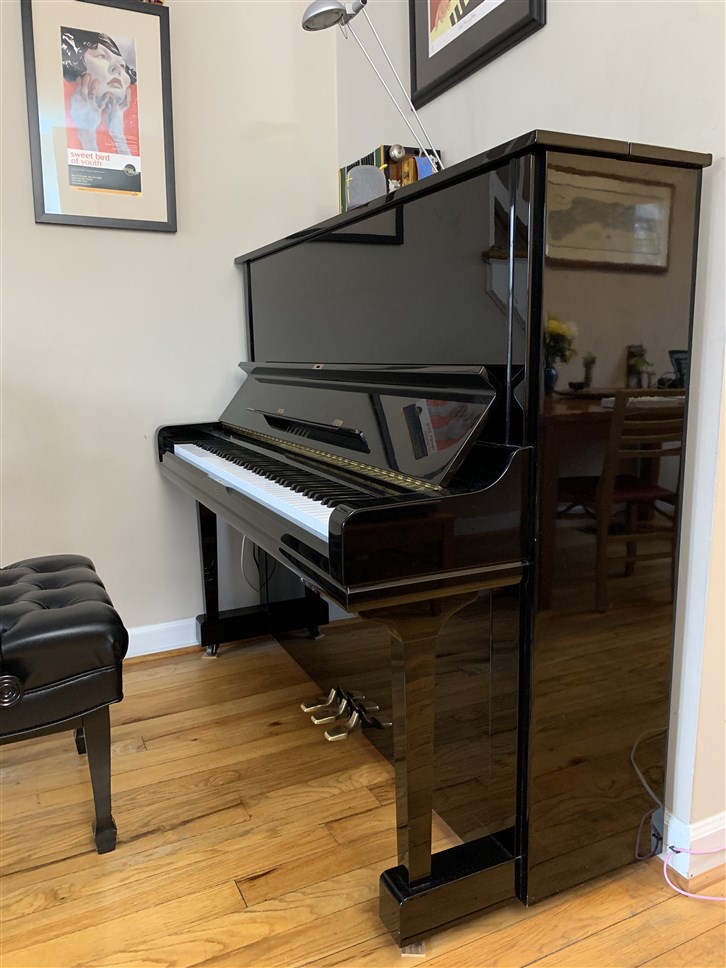 ACOUSTIC PIANOS Vertical (or upright) pianos are usually described by the following size categories: Spinets (36”); Consoles (41”); Studios (45”); and Uprights/Professional/full-sized (50”). Measurements are approximate and refer to the height of the piano from floor to top. Spinets and consoles were for many decades very popular entry-level home pianos; few have been made since 1990 as the low-cost segment of the market has shifted to digital keyboards, for good reason. If you can get an old spinet or console for free, or close, it could make a good starter piano, but in other cases, these should be avoided. As for the difference between studios and uprights: all things being equal, taller is better. Buy a full-sized instrument if you can. But any of these types, new or used, are suitable for beginner and intermediate students if the instrument is in good condition.
ACOUSTIC PIANOS Vertical (or upright) pianos are usually described by the following size categories: Spinets (36”); Consoles (41”); Studios (45”); and Uprights/Professional/full-sized (50”). Measurements are approximate and refer to the height of the piano from floor to top. Spinets and consoles were for many decades very popular entry-level home pianos; few have been made since 1990 as the low-cost segment of the market has shifted to digital keyboards, for good reason. If you can get an old spinet or console for free, or close, it could make a good starter piano, but in other cases, these should be avoided. As for the difference between studios and uprights: all things being equal, taller is better. Buy a full-sized instrument if you can. But any of these types, new or used, are suitable for beginner and intermediate students if the instrument is in good condition.
GRAND PIANOS A good grand piano over 5’9” is a major improvement over an upright. The cost of a decent grand is more than that of a comparable upright, but it’s perhaps not much as some people imagine. If you have the space and the means for a grand piano, rest assured that a good piano may outlive your children, will not lose value to the same extent that ordinary consumer products do, and will be superior in touch, reliability, and tone quality to most uprights. Avoid grands under 5’3”; instead consider a full-size upright. The term “baby grand” is not a reliable indicator of a piano’s size; find out a piano’s true size by measuring the length from end to end.
EDUCATE YOURSELF! If you’re purchasing a good acoustic piano, you’ll be making a substantial investment. It’s not unlike buying a car…but most people are more comfortable comparing cars than pianos! Among many different web resources, consider: rickjonespianos.com, pianopricepoint.com, pianobuyer.com, and of course your local dealers. In the D.C. area, consider: Jordan Kitts (Yamaha); Steinway Gallery (Steinway, Boston, Essex); The Piano Company (Kawai); Piano Craft; Rick Jones (good source for previously owned); Orpheus Music (good source for previously owned plus new Mason & Hamlin and Schimmel) If you have another good local dealer to recommend, let us know! Invest a little bit of time learning about the different choices within your market segment; you’ll be more able to evaluate information you get from dealers and more confident as you begin to narrow your options and make choices.
DEALER TIPS AND TRICKS Go to a dedicated music dealer. Skip the big box stores. If you can’t consider an acoustic piano, you may also check out a pro-audio dealer such as Sweetwater Sound. They may offer comparable digital pianos at lower prices than a piano dealer, especially at the lower end of the digital piano market. With certain brands, manufacturers distribute their instruments exclusively through a single retailer in a given geographic area. This means that your options for shopping around are restricted—at least for new instruments. Each local dealer can only sell the stock they have and the brands they represent. Be skeptical when a dealer gives you negative brand information about a product they don't sell. Most dealers list prices that are a little high, with the expectation that they will be bargained down somewhat. The potential for negotiation varies not only from dealer to dealer, but from brand to brand. If the dealer won’t negotiate and/or their prices are not close to what you’re expecting, find another dealer, or consider a different brand.
BRANDING TODAY With a few exceptions (most notably Steinway), “American” brands don’t mean much anymore. Some Japanese and Korean manufactures at one time made pianos in U.S. factories; most “American” brand names now come from Korea or China (and sometimes Japan). Some European-sounding names actually come from Europe, most come from Asia. Some new Yamaha piano models these days come from Japan but others are made in Indonesia. Both are acceptable for student use, but they are not directly comparable instruments—something you could guess by the large price difference between them. This brings up a sometimes-overlooked factor you may wish to consider when evaluating a piano: where and when was it was made. For example: a piano made in China in 1995 is almost certainly to be avoided, but a new piano made in China today under a respected brand name may be a suitable and reasonably-priced option.
UNIVERSITY SALES The pressure to buy is higher than at a regular retail store, but in most cases, these sales are run by the same local dealers you could visit at any time of the year. You can often get a lower price than at the dealer’s showroom, but not always. Go and look, but don’t be pressured to buy if you’re not ready!
TRADE UP CREDITS If you are buying a quality acoustic piano, it is unlikely that you will ever attempt to use trade-up credits. If you do use them, they may save you a little money, but they won’t save you a lot. A good-quality piano will retain much of its value, and dealers looking to make a sale are apt to be generous with the trade-in allowance, regardless of where you purchased the instrument.
GET A WARRANTY If you’re buying from a dealer or technician, your piano should come with a one-year warranty, regardless of whether it is new or used. Decline any deals that do not include this minimum level of protection. Reputable dealers may (and really should!) offer a longer warranty.
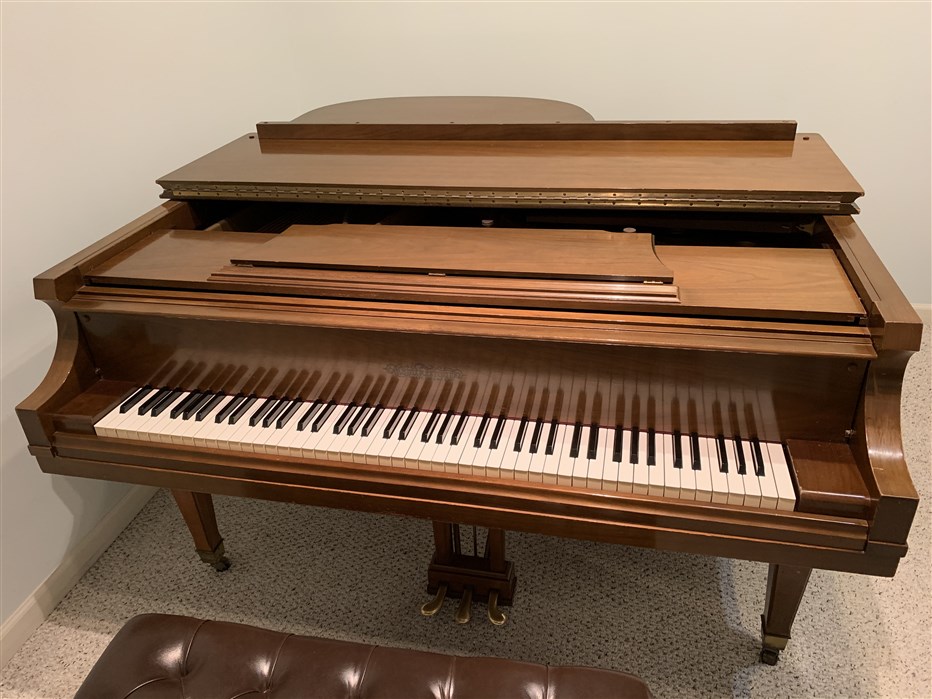 This piano is over 50 years old...and it sounds great!
This piano is over 50 years old...and it sounds great!
BUY USED When it comes to used pianos, it’s a buyer’s market! While you are recovering from new-piano sticker shock, consider whether a used piano might be suitable for you needs. You can usually get a much better deal buying a piano from a private individual than you can from a dealer; such transactions are also very risky for the buyer. It is unwise to buy from a private individual without having a trusted friend with some keyboard skills test out the piano first—and really, it’s best to hire an experienced technician to examine the instrument before you commit. Expect to pay $125-$250 for this service; it’s money well spent. If you're looking at the bottom end of the private market ($0 to $1500) you may get lucky and find a hidden gem! They’re out there! But you also need to be ok with the possibility that you'll be junking the instrument and upgrading at some unknown point down the road…and it might be sooner, rather than later.
YOU CAN DO IT! Unlike most consumer products, a piano is an investment for a lifetime—take your time, and good luck!
ADDENDUM: SO...HOW MUCH IS THIS GOING TO COST?
All prices are based on our personal experience with the Washington, DC-area market, over the course of many years. The price ranges on the market are truly staggering and range from free to nearly $200,000! The information below is only intended to get you a "ballpark" idea of what different types of instruments may cost.
ACOUSTIC INSTRUMENTS FROM DEALERS Used upright pianos of any quality go for $3000 and up. Used grand pianos start at around $8000. New pianos of any quality start at around $5000 for uprights and $11,000 for grands. Be skeptical of lower prices. Instead, consider used pianos. Remember these are ballpark starting prices for legitimate instruments—quality increases with higher prices at reputable dealers and the point of diminishing returns doesn’t start to be a factor until you reach at least triple the prices listed above: the Japan-made Yamaha U3 is among the best-quality upright pianos on the market today and its MSRP is around $15,000.
ACOUSTIC INSTRUMENTS FROM PRIVATE SELLERS You can usually get a used acoustic piano from a private seller for about ½ the dealer prices listed above—or less. Sometimes, much less. Usually, you’ll have to pay for moving and tuning—and most importantly, undertake the risk inherent in a private sale with no warranty.
DIGITAL KEYBOARDS The cheapest full-size digital keyboards start around $600; quality increases significantly as you pass the $1000 mark. The law of diminishing returns kicks in a bit over $2000, with the exception of a “hybrid” digital. The hybrid segment of the digital market starts at around $4000. Many models have a list price over $10,000. Buying a digital keyboard from a private seller is less risky than buying an acoustic instrument from an individual because it’s easier for you to test it out. If all keys work and seem to be of even weight (that is, you don’t find any heavy or sticky keys) and the speakers produce a good sound without distortion or static, you’re probably ok. You can usually expect to pay between 1/3 and 2/3 of the cost of a comparable new keyboard depending on the age of the instrument. Because prices have come down so low in recent years, you may find that 1/2 the price the original owner paid 10 years ago is pretty close to the current selling price for a comparable new instrument! It's a buyer's market. You can get a new entry-level digital piano for well under $1000, including stand, bench, and shipping. Keep this in mind when you're shopping for used. Most piano dealers won’t sell used keyboards; you may have to look at “pro audio” dealers to find used digitals in a store. It's fine if you can get one for free, but don't pay money for a used digital instrument over 15 years old. If something breaks, you probably will have a hard time finding parts to fix it. You should also exercise caution when considering a used hybrid digital piano, for the same reason.
Student Honors: Studio Master Class February 2021
Tuesday, March 9, 2021 | Student Awards and Honors
On February 20, 2021, we hosted our first-ever remote Master Class with guest artist John Healey. This was a chance for a handful of advancing students to challenge themselves in the demanding master class format and to get fresh perceptive from our wonderful guest artist! Congratulations to our participating students!
Aemi Bradford ♪ Sonatina Op. 20 No. 1, Kuhlau ♪ Owen Rollins ♪ Prelude and Fugue in A-flat Major from WTC 1, J.S. Bach ♪ Noah Tennenbaum ♪ Etude in C Major Op. 10 No. 1, Chopin ♪ Aruni Veluri ♪ Sonatina Op. 55 No. 1, Kuhlau ♪ Philip Wang ♪ Prelude and Fugue in c minor from WTC 1, J.S. Bach ♪ James Yao ♪ Romantic Sonatina, Schmidt
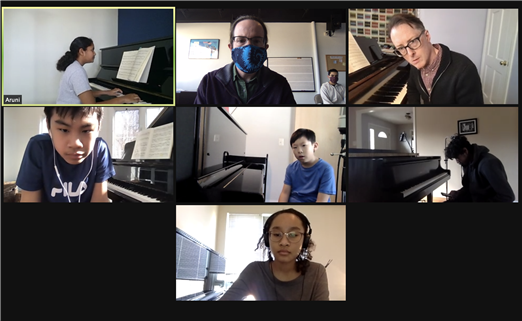
Student Honors: 2021 Golden Key
Sunday, March 7, 2021 | Student Awards and Honors
Many outside events have transitioned to a video-only format due to the coronavirus situation, but some events have been operating by video submission for many years! We are pleased to report that three of our students have been honored in one such long-running event, the Golden Key Music Festival. Congratulations to: Katrina Nelson (Silver) ♪ Zakariyya Scavotto (Silver) ♪ Alexa Garcia (Super Bronze).
Student Honors: December/January RCM Exams Part 2
Friday, March 5, 2021 | Student Awards and Honors
In addition to a handful of students already announced (see below), we've had two more results come through for the Fall/Winter RCM Exam season. Congratulations to Pelin Sarac (Level 7 Piano) Honors; and also to Elena Valdez-Torres (Level 4 Piano) First Class Honors.

